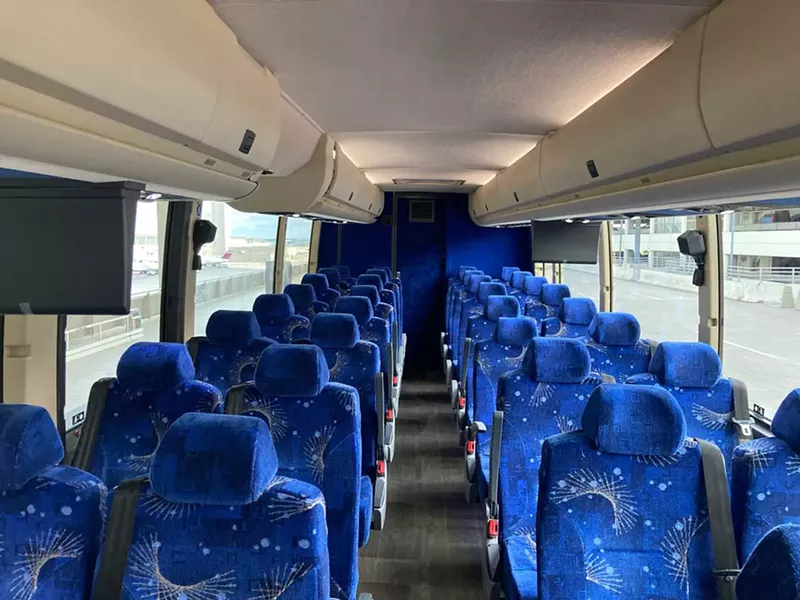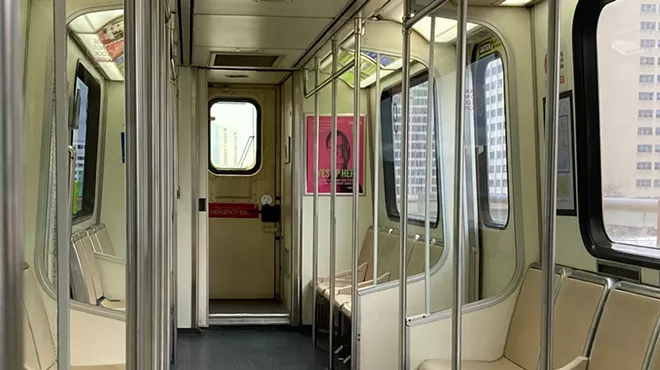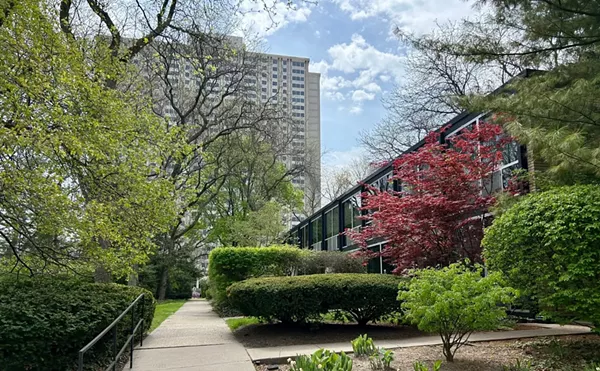Lapointe: For mass transit in Detroit, it’s a case of building the bus while riding it
The new downtown-DTW DAX Detroit line aims to change car culture in the Motor City


Audio By Carbonatix
[
{
"name": "GPT - Leaderboard - Inline - Content",
"component": "35519556",
"insertPoint": "5th",
"startingPoint": "3",
"requiredCountToDisplay": "3",
"maxInsertions": 100,
"adList": [
{
"adPreset": "LeaderboardInline"
}
]
}
]
The ride from downtown Detroit to Metro Airport was perfect. The big bus left on time. It arrived on time. The price was right. The vehicle was clean. The driver was courteous to passengers and careful behind the wheel.
The drop-off point was ideal, too, mere steps from the door of the departure level of the McNamara terminal. The trip was smooth and quiet. In fact, a little too quiet. Although the bus held about 50 passenger seats, only seven were filled on the ride to the airport; on the return trip, just six.
“We’re starting to build it, piece by piece,” says Ben Stupka, executive director of the Regional Transit Authority of Southeast Michigan. He is speaking of both the airport bus service specifically and of regional transit in general.
“We’re working to run it for at least a year,” he says of the airport bus. “We’ll see how that service goes. And, if it’s successful . . . expand.”
Stupka is one of those optimistic visionaries trying to build a mass transit consciousness in a Motor City region that has rejected such thinking for decades. Although some bus lines on the west side already stopped at the airport, this “DAX Detroit” (Detroit Air Express) line was established in the spring to provide direct, non-stop service from downtown.
I took it both ways last Thursday, starting on Washington Boulevard, across the street from the Westin Book Cadillac hotel and around the corner from the Rosa Parks transit center. Technically, the fare is $8, although there is a $2 discount for online booking. Senior fare is $4 and the driver took cash.
During the lull between rides, I shopped comparative fares back to downtown from the airport. The guy at the “Metro Cars” desk told me the downtown fare was $65; the guy at the “Metro Cab” desk said his rate was $50. All things considered, the DAX bus seemed like the best deal.
In addition, the DAX bus includes a rest room and charging ports at the seats to add juice to your cell phone battery. They store your luggage in a cargo hold. The bus stops at both terminals. The service runs seven days a week with 16 trips each day, each way.
But, how many customers are making the trip?
“About 150 a day, it’s pretty steady,” Stupka says in a telephone interview. “About 4,000 a month. It’s exceeded expectations. Pickups are even, in and out.”
Stupka says more riders than expected have been people who work at the airport. Demographic surveys are on the way, he says. The route is funded under a federal grant of more than $1.5 million, he says, administered by the Southeast Michigan Council of Governments in a carbon reduction program.

But what about the bigger picture? Big cities like Atlanta, for instance, have a rapid transit train system that goes directly to the airport for a $2.50 fare. In addition, the system serves the whole city and its suburbs. New York, San Francisco, Boston, and Washington are among cities with rail transit.
But not Detroit, which abandoned its streetcar system in the mid-1950s. Detroit-area streets, as local commuters all know, are designed in a “spokes-of-a-wheel” pattern with big medians down some major roads like Woodward and Gratiot in the suburbs.
While sometimes confusing to drivers, the layout would seem ideal for surface-level rapid rail transit, the way other cities built their systems in the 20th Century. But Stupka sees a broader need for 21st Century solutions.
“We’ll have to retrofit to development patterns of our communities,” he says. That means more and better buses and more “flex bus” service and on-demand pickups. He is not against rail transit, he says, but solutions must be diverse.
Stupka took his current position last January, but has worked with the RTA since 2015. He is a graduate of Birmingham Seaholm High School and Michigan State University with a postgraduate degree in urban planning from the University of Michigan.
In addition to the DAX line to the airport, Stupka’s agency also has operated for three years a non-stop bus service between Ann Arbor and downtown Detroit. On Oct. 1, the RTA will take over the operation of Detroit’s QLine (the M-1) that carries passengers by train for free up and down Woodward to the New Center.
Before considering expansion of it, Stupka says, his group will prioritize efforts to solve current problems, like people parking their cars on the train tracks, a perfect example of the Motor City mentality that the RTA is trying to change.
Other challenges seem more mundane but still important. For instance: Stupka would like to put a bus shelter for the DAX airport line near the downtown pickup point. But that involves several layers of bureaucracy.
“If you are going to put a pole in the ground you might have to do an archeology review,” he says.
After that comes environmental studies. Will the shelter block a view of an historic building? And what impact would a bus shelter have on curb parking?
All in a day’s work for a busy man with an important and necessary task. In that “a journey of a thousand miles begins with a single step,” the RTA is taking hopeful steps. Its wheels are turning. Let’s stop throwing mass transit under the bus.







